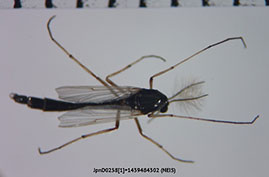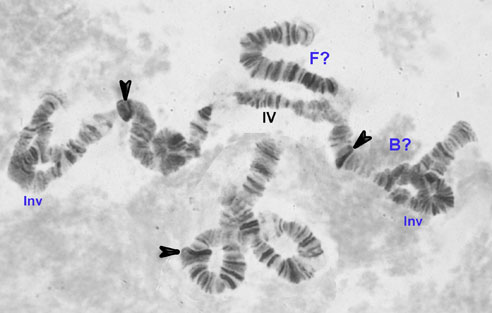Benthalia species 3
In BOLD Bin: BOLD:AAW3454
This species was collected at the same time in Lake Suwa as Benthalia sp. 2. Both species had larvae late enough in 4th instar to be able to be sexed, suggesting they breed at about the same time. However it is not known whether they were sampled from different places in the lake, or on different substrates, potentially even from different depths.
Adult: Some details of the males can be determined from the photographs in the CDBD, since those specimens are placed in the same BOLD Bin.
Color dark brownish black, legs yellowish, but darkening on tarsi; but some specimens have a yellowish base color of the thorax and more dull green on abdominal segments I-VII, but posterior end of segment VII, and segments VIII and IX almost black. Mid F/T about 1.1; Hind LR about 0.7, F/T about 0.9-0.94.

JpnD0258[1]+1439484302 (NEIS)
Incorrectly identified in BOLD database as C. longipes.
Fourth instar larva: A single pair of ventral tubules.
Frontoclypeus without a depression near the anterior margin, but with rugosity on the anterior margin of the frons.
Clypeal aperture roughly trapezoidal, 81 µm long, 25 µm wide (3.2 times longer than wide).
Gula region darkened over posterior half. VHL 220 µm; mentum width 152 µm, 0.69 of VHL
Mentum (Fig. c) essentially with 13 teeth (c2 teeth barely demarcated from c1); 4th laterals reduced to level of 5th laterals (Type II-III).
Ventromentum (Fig. d) 164 µm wide and 3.7 times longer than deep; 1.08 times wider than mentum; plates separated by about 0.37 of MW; with about 47 striae.
Pecten epipharyngis (Fig. b) roughly triangular, with many very small teeth. Premandible (background of Fig a) with long teeth, inner tooth about 4-4.7 times wider than outer tooth (due to very narrow outer tooth).
Antennal bases separated by 104 µm, wider than the distance between the S4 setae (91 µm, which is 0.88 of the Frontoclypeal width at that point).
Antenna (Fig. b) relatively short, A1 about 2.25 times longer than wide and only about a quarter the VHL, RO about 0.41–0.52 up from base; AR 1.18; proportions (micron) 57 : 21.5 : 6 :14 : 6.
Mandible (Fig. e) length 187 µm, essentially Ty. IIB; 7 widely separated furrows, 12 taeniae in Pecten mandibularis; MTR - 0.36.
Cytology: Four polytene chromosomes.
All long chromosomes with heterochromatic centromeres, 2 quite heavily heterochromatic but the third, which looks like arms B and F of the Chironomus karyotypes has thinner centromeric band. It may also contain the nucleolus. No apparent nucleolus in chromosome IV, and no obvious heterochromatic centromere. A large simple inversion was present in what could be arm B and in one arm of a another long chromosome.
 B? & F? - arms with possible homology to arms of Chironomus; arrows - centromeres; IV - small chromosome IV; Inv - heterozygous paracentric inversions.
Found: Japan: - Lake Suwa (36.03°N, 126.10°E), Honshu; Wakaguri 36.144°N, 140.083°E Tsukuba, Kanto (NIES) (see C. dorsalis).
B? & F? - arms with possible homology to arms of Chironomus; arrows - centromeres; IV - small chromosome IV; Inv - heterozygous paracentric inversions.
Found: Japan: - Lake Suwa (36.03°N, 126.10°E), Honshu; Wakaguri 36.144°N, 140.083°E Tsukuba, Kanto (NIES) (see C. dorsalis).
See also Benthalia species 1, Benthalia species 1a, Benthalia species 2, Benthalia species 4.
[ Return to Benthalia carbonaria
| Index
| Go to References ]
|

 B? & F? - arms with possible homology to arms of Chironomus; arrows - centromeres; IV - small chromosome IV; Inv - heterozygous paracentric inversions.
B? & F? - arms with possible homology to arms of Chironomus; arrows - centromeres; IV - small chromosome IV; Inv - heterozygous paracentric inversions.